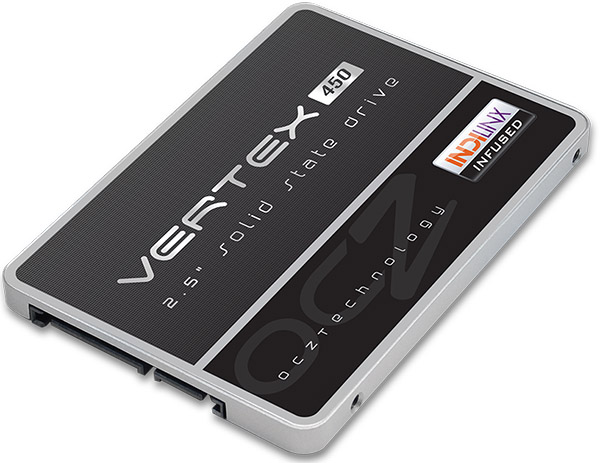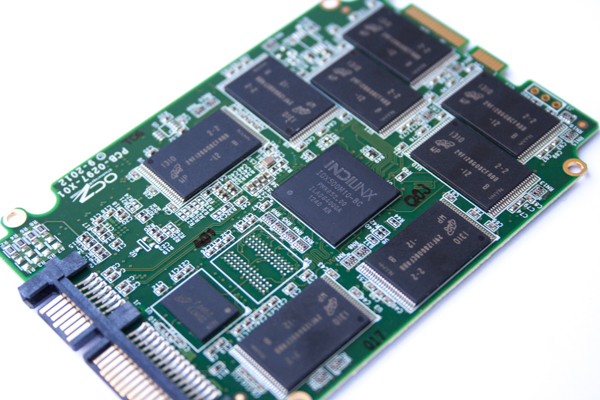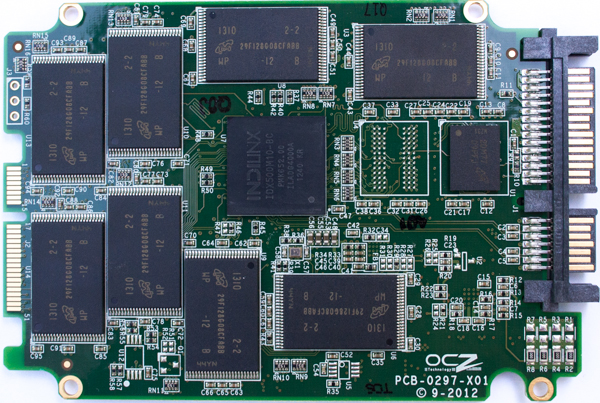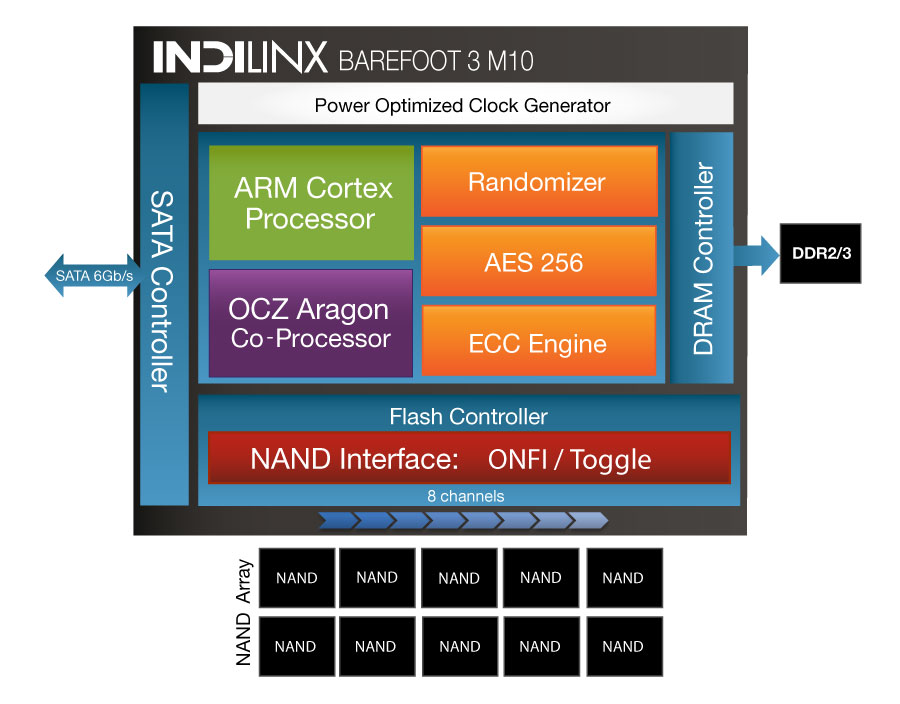OCZ Vertex 450 256 GB SSD Review: Can We Call It Vector Jr.?
OCZ is shaking up its current product stack by replacing the year-old Vertex 4 SSD. The Vertex 450 matches Barefoot 3 controller silicon with 20 nm synchronous NAND for something slightly more economical than the company's current flagship, the Vector.
OCZ's Vertex SSD Family Evolves, Again
For several years now, OCZ has been on a long, strange journey. It started reselling Samsung-based drives and now has its own proprietary controller technology driving designs built in-house. Despite some bumps along the way, progress was steady, and today's OCZ is an entirely different company than it was back when it started down the storage path.
OCZ's Vertex family serves as a yardstick of that adventure, each successive generation accompanied by a different technology under the hood. The first Vertex (the Indilinx Barefoot-based original) wielded Cognac firmware. Back then, that Barefoot controller was all the rage and any company serious about SSDs was using it. It took a company called SandForce to knock Indilinx off of its throne. OCZ was one of the first vendors to make that transition with its Vertex 2. Then, when SandForce launched a second-generation controller in early 2011, OCZ wasted little time dropping it into the Vertex 3.
It's hard to say what might have happened after that had LSI not bought SandForce and OCZ not purchased Indilinx. But both companies were acquired in 2011. Indilinx never got off the ground with its Barefoot successor, and SandForce had already introduced the 2000-series controller by the time LSI dropped it into a generously-sized portfolio.
Since OCZ already had a partnership with Marvell, moving to that company's silicon wasn't such a stretch for the Vertex 4. Despite Indilinx branding, it wasn't OCZ's controller; it only played a hand in the firmware. When that fact become widely known, the fickle enthusiast community frowned collectively at the less-than-forthcoming marketing (even if the knowledge meant little otherwise). Companies that employ SandForce controllers are locked into its firmware package. Those that lean on Marvell's technology purportedly can't get complete firmware at any price. In that way, Marvell's SSD processors are almost a blank slate, since every software package is custom. Different implementations can have radically different characteristics. If nothing else, the one thing you can say about the Vertex 4 is that it has wildly different characteristics, such as a mode that addresses some flash like SLC NAND for higher performance at the expense of temporarily lower performance when the drive fills up.

Eventually, the first Barefoot 3-based SSD from OCZ surfaced in the Vector, retaining similar Vertex 4-like performance attributes. That drive achieved peak benchmark results that put it in direct contention with the fastest competition when it launched a few months back. It was aimed full-on at the enthusiast, with speed, software, and pricing to match.
Today, OCZ is launching a new Vertex based on a similar controller as a replacement for the Vertex 4. Dubbed the Vertex 450, it pairs 20 nm flash and a version of the Barefoot 3 to hopefully enable much of the Vector's brutal speed with a commensurate drop in price.
| OCZ Vertex 450 | 128 GB | 256 GB | 512 GB |
|---|---|---|---|
| Controller | OCZ Indilinx Barefoot 3, IDX500M10-BC | ||
| NAND | 20 nm Micron MLC, 64 Gb | ||
| Interface | SATA Revision 3.1 | ||
| Warranty | Three Years | ||
| Seq. Read/Write MB/s | 525/290 MB/s | 540/525 MB/s | 540/530 MB/s |
| Random Read/Write IOPS | 75,000/70,000 IOPS | 85,000/90,000 IOPS | 85,000/90,000 IOPS |
| Die Count | 16 | 32 | 64 |
| MSRP | $130 | $235 | $500 |
You might find it odd that OCZ isn't calling its latest effort the Vertex 5. After all, this isn't merely a Vertex 4 with smaller-geometry NAND. It represents a significant departure in almost every way. Early (inaccurate) reports pegged this drive as a Vertex 5, but the company is presumably saving that name for some future configuration. For now, there are three capacities of the Vertex 450 (128, 256, and 512 GB), and we have the 256 GB model on our test bed today.
Get Tom's Hardware's best news and in-depth reviews, straight to your inbox.
According to OCZ, the 256 GB Vertex 450 is capable of 540 MB/s reads and 525 MB/s writes, along with 4 KB random performance approaching 90,000 IOPS. That puts it just shy of the Vector, at least as far as manufacturer specifications go. Unlike the flagship, which is protected by a five-year warranty and comes with a complementary copy of Far Cry 3, the Vertex 450 gets a three-year warranty, Acronis True Image for drive cloning, and a 2.5"-to-3.5" adapter sled.
A Peek Inside the Vertex 450
The Vertex 450 is covered by the same attractive metal chassis as the Vector. It does add some weight, though it looks great aesthetically and feels substantial in-hand. Sure, we know that what's inside counts most, but it sure doesn't hurt to have a sharp-looking exterior, too.

We find a Barefoot 3 M10 at the Vertex 450's heart. Surrounding it are eight emplacements of dual-die 20 nm MLC NAND from Micron. Eight more packages are soldered onto the back of the PCB, giving this 256 GB drive 32 total 64 Gb die. The middle-capacity Vertex 450 also employs two 256 MB DDR3-1600 modules (one per side), though if previous trends carry over, the 512 GB SSD will likely include 1 GB of cache.


Shifting to 20 nm NAND should lighten OCZ's bill of materials, leaving wiggle room for lower pricing. At least, that's the theory. Very few SSDs launched in 2013 still use flash manufactured on nodes greater than 19-21 nm.
Later in its life, the Vertex 4 shipped with Micron NAND, eschewing Intel's flash for a slight performance drop and better pricing. At least that transition was accompanied by a naming update that made the change visible to potential customers.
As for the Vertex 450, the dip in performance compared to the fancier Vector could come from a few different places. We know for a fact that the controller, at least, isn't as fast.

A Slightly Different Engine Under the Hood

Again, some of the difference between OCZ's Vector and Vertex 450 come from the controller. Not that it's significantly changed, but OCZ claims the M10 version runs at reduced clock rates compared to the Vector's M00 processor. The Vertex 450 also includes AES-256 encryption support, though it's uncertain whether this was missing or deliberately disabled on the flagship.
The M10's lower speed is an attempt to get better yields from silicon that wouldn't otherwise hit the frequencies required for the Vector's design, or at least not without sailing past ARM-class TDPs. Intel and AMD have plenty of SKUs that weren't cut out to be higher-end products, so they run at lower clock rates or turn certain sections off. Either way, they can still make money crippled. That's standard practice in the CPU and GPU markets, but it's less common to see this yield dynamic discussed with regard to flash controllers. We're not saying it doesn't happen; most vendors don't talk about it.
Current page: OCZ's Vertex SSD Family Evolves, Again
Next Page Test Setup And Benchmarks-
boulbox Kinda wanted to see 840 pro match up with it too. Guess it doesn't really matter since we could just go find your other benchies on it and compare it ourselves but i thought it would just be nice to have it up there.Reply -
Faisal Mahmood Speed and performance are fine but what really counts is reliability which OCZ does not have. I had to RMA Vertex 2 twice and both times it lasted 8 months. Before that I invested in an Intel x25-m and it is still going strong.Reply -
s3anister Just bought another 840 Pro. Really can't trust OCZ anymore after so many failed Vertex 3s.Reply -
slomo4sho It is pretty common to find quality SSDs in the $0.55-0.65/GB range these days. Game coupon aside, the price of this SSD isn't all that competitive.Reply -
technerd Faisal MahmoodSpeed and performance are fine but what really counts is reliability which OCZ does not have. I had to RMA Vertex 2 twice and both times it lasted 8 months. Before that I invested in an Intel x25-m and it is still going strong.SAME! I'm going to Samsung for my next SSD. OCZ's reliability is a jokeReply
-
kitsunestarwind I love OCZ The Vertex4 series SSDs have been nothing but rock solid reliable, much better then their earlier offerings and the problems with the Vertex2/3 series drivesReply -
cryan slomo4shoIt is pretty common to find quality SSDs in the $0.55-0.65/GB range these days. Game coupon aside, the price of this SSD isn't all that competitive.Reply
The Vector gets the Far Cry 3 coupon until July 14th while the Vertex 450 doesn't get it at all. If you're having to choose between the two, the Vector is probably the better bet unless the V450 is significantly cheaper. It's hard to say what the Vertex 450 will cost once generally available, but it'd be prudent to expect prices to be higher for the first few weeks. Initially, the Vertex 450 will probably be near the $235 mark, only a few bucks less than the Vector (about $15). Is it worth giving up two years of warranty and a FC3 coupon to save $15? You be the judge.
Regards,
Christopher Ryan
-
cryan boulboxKinda wanted to see 840 pro match up with it too. Guess it doesn't really matter since we could just go find your other benchies on it and compare it ourselves but i thought it would just be nice to have it up there.Reply
Stay tuned, because we're working on it. I've been rebuilding the entire database of comparative consumer SSD performance data, and some drives haven't been done yet for one reason or another. In some cases, it's due to time constraints. In other cases, acquiring or reacquiring particular SSDs has been problematic.
Regards,
Christopher Ryan
-
dgingeri I'd like to see it's relative performance compared to a Vertex 4. I have two Vertex 4 drives, a 256 and a 128, and I've been wondering how these new drives would compare, and if they're worth spending the money to swap with my Vertex drives.Reply -
raidtarded Later in its life, the Vertex 4 shipped with Micron NAND, eschewing Intel's flash for a slight performance drop and better pricing.Reply
Doesn't Intel and Micron use the same NAND via the IMFT partnership?